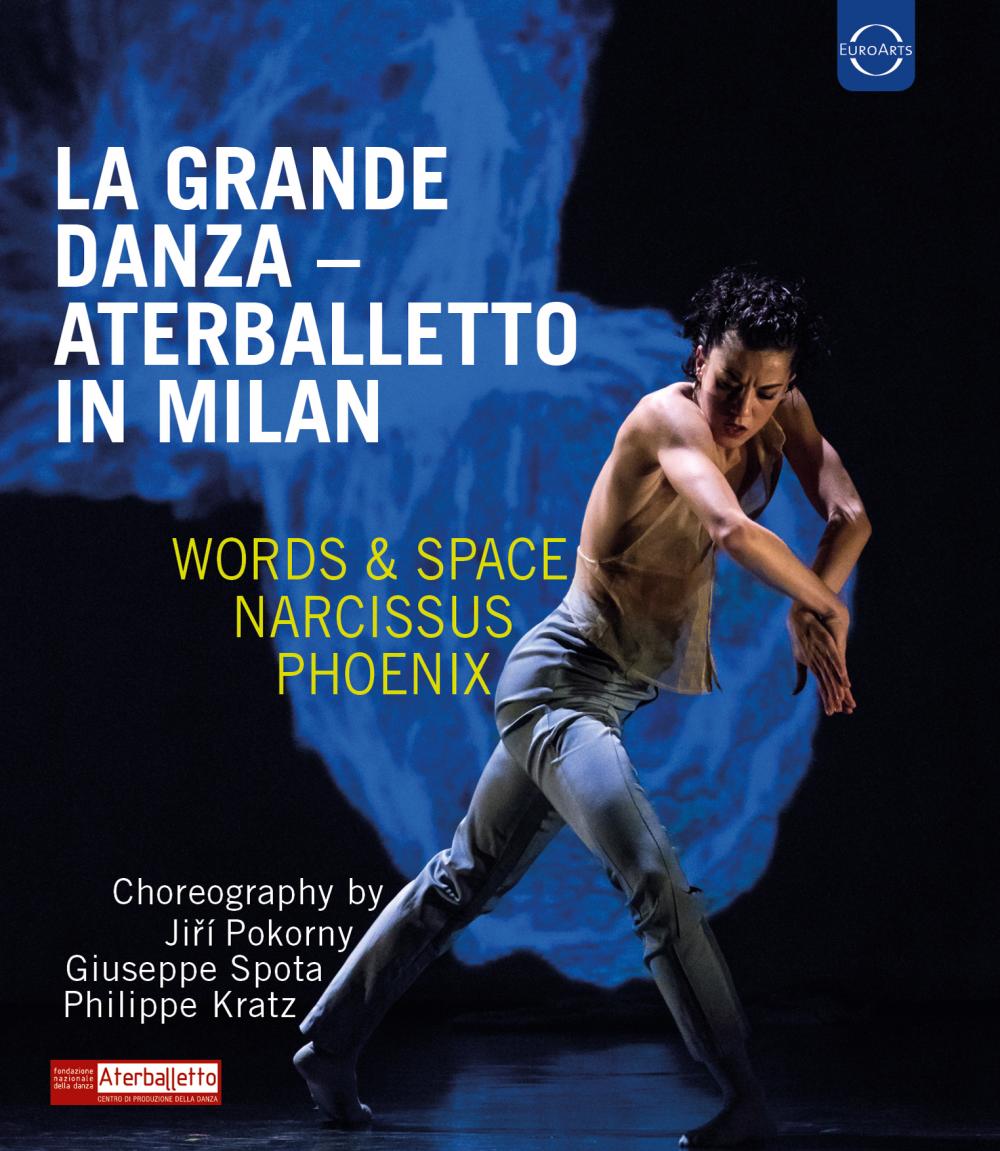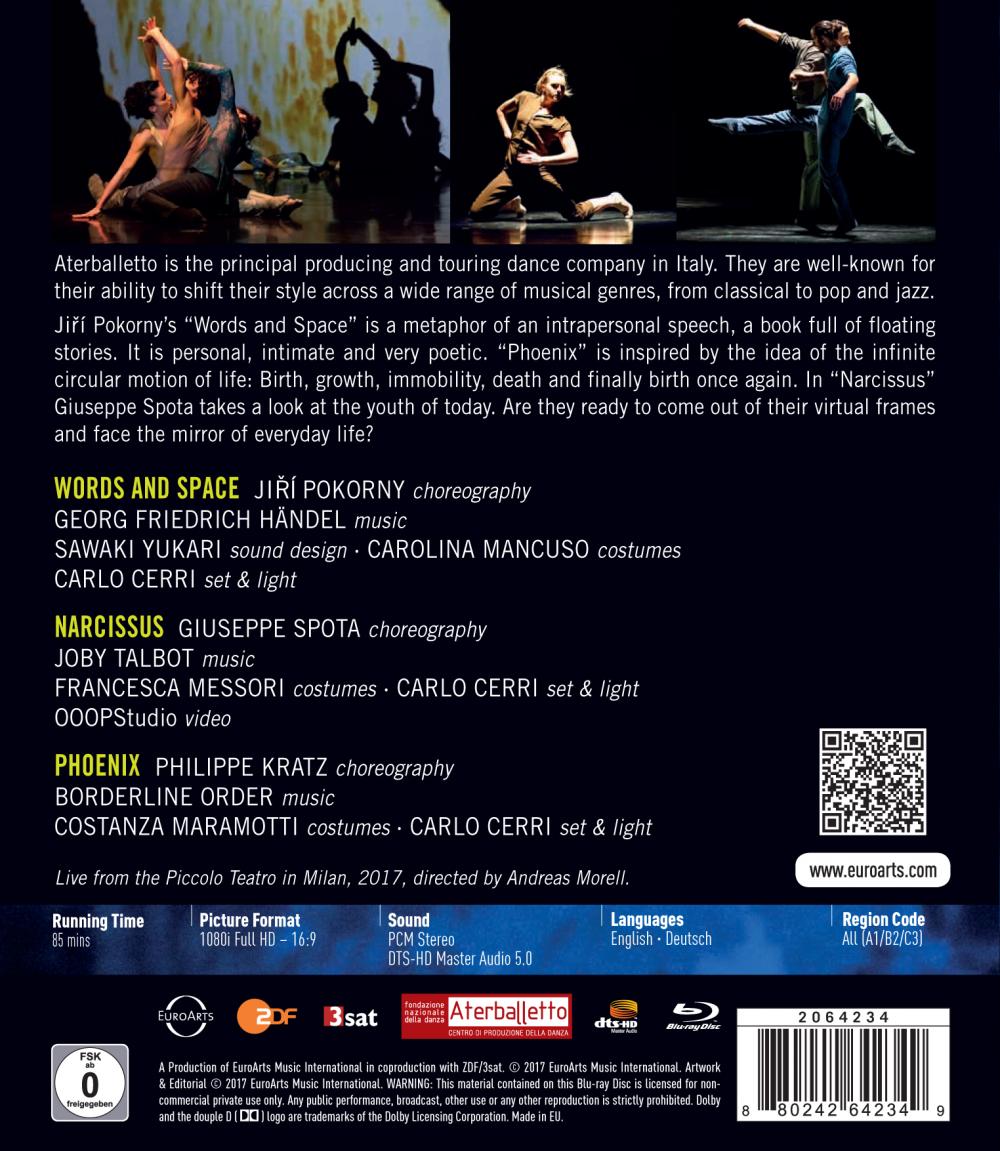

La grande danza—Aterballetto in Milan triple bill of dances. Performed 2017 by the Aterballeto Dance Company at the Piccolo Teatro in Milan. Here’s the program:
Words and Space. Choreography by Jiří Pokorny. Music by Georg Friedrich Händel. Sound design by Sawaki Yukari; costumes by Carolina Mancuso; sets and lighting by Carlo Cerri.
Narcissus. Choreography by Giuseppe Spota. Music by Joby Talbot. Costume design by Francesca Messori; sets and lighting by Carlo Cerri; on-stage video designs by OOOPStudio.
Phoenix. Choreography by Philippe Kratz. Music by Borderline Order. Costume design by Costanza Maramotti; sets and lighting by Carlo Cerri.
Directed for TV by Andreas Morell; director of photography was Henning Brümmer. Released 2017, disc has 5.0 dts-HD Master Audio. Grade: B+
Fondazione Nazionale Della Danza ATERBALLETTO (full name) is a leading contemporary dance company in Italy. ATER stands for the "Association of Theaters in Emilia-Romagna". The company originated in and is still based in Reggio Emila, a small city in Northern Italy. It also appears to be the largest dance company in Italy that is not operated by an opera house. It is a producing company and its dancers are constantly on the move touring theaters in Italy and other countries.
We start with two location shots of Milan, where La grande danza was filmed:
Each of the 3 works begins with a short introduction by its choreographer. The works are not discussed in the keepcase booklet, which only has 2 pages with a track list, the names of the dancers (alphabetical order) in each piece, and technical credits.
Words and Space
Jiří Pokorny, guest choreographer, explains in his introduction that Words and Space depicts the inner thoughts of a single character, whom we will call "the man." The other dancers represent inner voices that arise from various thoughts of the man. Some of these inner voices are male and some female. Pokorny imagines we are all confined indefinitely to an empty space populated by our inner voices. We don't know if Pokorny's concept has any basis in psychology or brain science. Perhaps the inner voices are stand-ins for all the people and forces that affect us as we go through life.
Below are two shots of "the man" played by, we think, by Saul Daniele Ardillo. The other dancers are Damiano Artale, Hektor Bublla, Martina Forioso, Philippe Kratz, Ina Lesnakowski, Valerio Longo, Ivana Mastroviti, Roberto Tedesco, Lucia Vergnano, Serena Vinzio, and Chiara Vascido:
Next below we see the inner voices in formation:
Sometimes the inner voices function as a unit vis-a-vis the man, who is in the image below crouched behind the woman in the center:
The inner voices explode:
In the rest of the piece, various dancers relate to each other in numerous ensembles. TV director Andreas Morell starts off his film with various whole-body scenes. But Morell also produces many close-up and aerial angles so that the home audience sees the production in a significantly different way than the audience in the Piccolo Teatro:
A duet of two women:
Next below are two dramatic views from the same male duet:
The music for Words and Spaces consists of mysterious sounds and mutterings from Sawaki Yukari with 3 shorts segments from Handel woven in. All this seems a bit bland to us; we aren't sure if the music is a help or a hurdle for Pokorny. We did a Dance Wonk Worksheet for Words and Space. The video pace was only about 5 seconds per clip, a fast speed which we normally associate with DVDs. There are perhaps 15 to 20 split-second clips which clutter up the video while contributing little.
We counted 14 aerial shots as whole body views. Even then, less than 50% of the clips have whole-body images. We would normally sharply criticize a classical ballet or narrative dance video with so many short and close-up clips. But there may be justification for Morell to shoot Words and Spaces as he did. 12 dancers get swallowed up by the rather large stage (even if it was the Milan Picolo), and the chiaroscuro setting has the dancers mostly performing in blackout. Whole stage shots leave the dancers looking isolated and forlorn. Probably the best way to see this live was to sit quite close to the stage. Well, Morell takes the HT viewer in even closer rather than risk boring his audience. And by going in, Morell gets to contribute his amazing fine-art shots of the human body. We think these comments about video content apply also to the Narcissus and Phoenix pieces that follow.
Narcissus
We needed to brush up on the Narcissus myth, so we consulted Ovid. He says Narcissus is simple: although all the girls (and boys) lusted for Narcissus, he fell in love with his own image. He then ignored all others except Echo, who always agreed with him. Giuseppe Spota, guest choreographer, takes a different tack. He views Narcissus as a symbol of our fascination with the superficial world of appearances. Spota creates a dopplegänger character for each of his "myth" dancers. These parallel protagonists represent deeper human qualities that can't be seen from a glance.Dance Wonk Worksheet for
Next below is a portrait of Narcissus, played by Roberto Tedesco:
And here's Echo played by Ivana Mastroviti:
Now we see Narcissus and Echo with their doppelgängers played by Saul Daniele Ardillo and Serena Vinzio:
The foursome engage in various formations in a set that changes numerous times with video projections:Dance Wonk Worksheet for
The Jody Talbot music for Narcissus was quite pleasant and seemed well suited to the proceedings on the stage. The video projections are effective in showing that the these two couples, though related, dwell in different realms.
Phoenix
Philippe Kratz is a dancer with Aterballetto and a budding choreographer. He describes his piece as a tribute to all those persons who have drawn on their personal resources and strength to recover from adversity. The dancers are Saul Daniele Ardillo, Damiano Artale, Martina Forioso, Ina Lesnakowski, Grace Lyell, Giulio Pighini, Roberto Tedesco, Lucia Vergnano, and Serena Vinzio. In the first image seen below, we see a group of people who are down and out:
Self-help:
Below a dramatic close-up:
Proof of recovery:
Groups form up to march jauntily about the set:
Aided by dramatic lighting, Kratz somehow manages to command the entire stage with only 9 dancers:
In his introduction, Philippe Kratz thanked Borderline Order for the original music written especially for this ballet. The choreography fit like a fine glove on the elegant hand of the music. We also did a Wonk Worksheet on Phoenix. We thought the video pace of Phoenix would be substantially slower (better) for than for Words and Space. Wrong. This shows how hard it is to judge the pace of a film accurately even if you think you know what you're doing. But Phoenix did have a better whole-body count than Words and Space. We think the three pieces in this record are of equal quality. But we liked Phoenix the best, probably because the dancing, while not narrative, was relatively easy to relate to the theme of the work as described by the choreographer.
Does all this looks familiar to you? Well, it's brought to you by many of the same folks who did the popular Blu-ray dance title Caravaggio in Berlin in 2008. The choreographer for Caravaggio was Mauro Bigonzetti, who was full-time at Aterballetto for about 13 years and has contributed more than 30 works to the company repertory today. The dramatic lighting and set design for Caravaggio came from Carlo Cerri who also did most of the lighting and set construction for La grande danza. Finally, Andreas Morell was also TV director of Caravaggio and he used Henning Brümmer as director of photography for both Caravaggio and La grande danza. If you will look at our screenshots for the Caravaggio review, you will see that the 3 young choreographers working in La Grande Danza are following a path directly behind the masters who did the Caravaggio production in Berlin.
This title is not at the same Wow! level as, say, the Wayne McGregor Chroma/Infra/Limen triple bill. I'll put it up against Alonzo King LINES and the Keersmaeker Rain and give it a B+.
Here is a short clip of Narcissus which shows some of OOOPStudio's video projection work:
OR






















